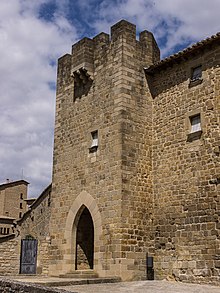Sancho Ramírez, Count of Ribagorza
| Sancho Ramírez | |
|---|---|
| Count of Ribagorza | |

Castle in Sos, governed by Sancho Ramírez
|
|
| Spouse(s) | Beatriz |
|
Issue
See Descendants
|
|
| Noble family | Jiménez dynasty |
| Father | King Ramiro I of Aragon |
| Mother | Amuña |
| Born |
c. 1043 Aragon |
| Died | 1105/November 1110 Aragon |
| Buried | Jaca Cathedral |
Sancho Ramírez (before 1043 – 1105/November 1110) was an illegitimate son of King Ramiro I of Aragon and Amuña, the firstborn and brother of his namesake who would inherit the throne and reign as Sancho Ramírez.
Even though he could not inherit the throne because his father had legitimate issue, he was named count at an early age and was a prominent member of the curia regis first appearing in a charter dated 1049, suspected of being false, as a witness to a donation made by his father to the Monastery of San Victorián. In this charter, he confirms as Sancius Ranimiri regis filius primogenitus (Sancho, the firstborn son of King Ramiro) followed by his brother and namesake, Sancho, who confirms as Sancius Ranimiri regis filius prolis Ermmisendis regine (Sancho son of King Ramiro and Queen Ermesinda). Sancho was entrusted with the governance of several important and strategic tenencias, including: Aibar (1061 – 1062); Sos (1062); Benabarre (1063 – 1093); Fantova (1063 probably until 1110); Ribagorza (1083 – 1093); Monzón (February 1090); Arrieso (January 1091), and Javier (September 1091 to December 1097); and, Aibar, again from September 1091 until March 1100.
Sancho Ramírez probably participated in the Reconquista as can be inferred from his father's first will executed on 29 July 1059 when the king included him as one of his heirs if he returned from the "land of the Moors". In his second will dated 15 March 1061, his father left him Aibar and Javierrelatre "with all its villas". In 1092, when he was already in his fifties, he went on a pilgrimage to Jerusalem which at that time was occupied by the Seljuq dynasty. He was a generous patron of several religious establishments such as a church in Lasieso, San Salvador de Javierrelatre, and Jaca Cathedral where he commissioned the construction of a chapel for his burial.
...
Wikipedia
